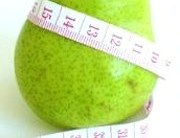Varicose Veins & Diet: Treat Enlarged Veins With These 5 Diet Tips
What is the best diet plan for treating varicose veins, those painful enlarged veins that develop in some women's legs, especially during and after pregnancy? The purpose of this section of HealWithFood.org's Guide to Healing Varicose Veins is to provide you with diet tips that can help you prevent and treat varicose veins and spider veins.
Important notice: The information below and elsewhere on this website is not intended to be a substitute for professional medical advice, diagnosis or treatment. Always seek the advice of your physician or a qualified health care professional for any questions you may have regarding varicose veins or any other medical condition.
#1: Restrict Calories Consumed
A high energy intake is associated with an increased risk of varicose veins because it can contribute to the development of obesity and excess body weight. Many people have experienced a dramatic improvement in the appearance of varicose veins by losing as little as 10% of body weight. To lose weight, you will have to create a calorie deficit, either by reducing calorie intake from foods so that your body must draw on reserves for energy (such as fat stored within your body) or by increasing physical activity.

To lose 1 pound per week, you need to create a deficit of 3,500 calories per week. This can be done by reducing a daily caloric intake by 500 calories per day (500 calories x 7 days = 3,500 calories). Most health professionals recommend creating a caloric deficit of 3,500 to 7,000 per week for healthy and successful weight loss.
An extreme caloric deficit (a deficit of more than 7,000-10,500 calories per week) can compromise bodily functions and even result in heart rhythm abnormalities, which can be fatal. Furthermore, cutting too many calories may also be counterproductive to weight loss efforts, as extremely low calorie diets boost the activity of fat-storing enzymes and decrease the activity of fat-burning enzymes in the body. In addition, cutting too many of calories can accelerate loss of lean muscle mass and decrease the output of the thyroid hormone, which will result in a decrease in the metabolic rate and thus fewer calories will be burned throughout the day.
In addition to restricting the amount of calories consumed, overweight people with varicose veins should pay attention to the timing of the daily caloric intake. It is generally recommended to spread the calories throughout the day by having 5-6 small meals. This will keep the metabolism humming and reduce cravings for sweets and starches, thus promoting weight loss. The breakfast should be the biggest meal of the day as a big breakfast will rev up your metabolism and you will burn more calories throughout the day.
#2: Eat Plenty of Foods Rich in Vitamin C
If you have varicose veins, one of the best diet tips you can follow is to include plenty of foods rich in vitamin C and vitamin E in your daily diet. Vitamin C is needed for the manufacturing of collagen and elastin, two important connective tissues that help keep veins strong and toned. Vitamin C is also known to increase circulation. Therefore, it is no surprise that a deficiency of vitamin C has been associated with varicose veins. The positive effects of vitamin C on blood vessels are believed to be more pronounced when vitamin C is consumed together with vitamin E.
#3: Eat Plenty of Fiber Rich Foods
Dietary fiber is the part of plant foods that the enzymes in your body cannot digest. It is therefore not absorbed into the bloodstream and cannot be used for energy. Dietary fiber can be classified into two main categories: soluble and insoluble fiber. Soluble fiber forms a gel when mixed with water while insoluble fiber, which does not dissolve in water, passes the intestines largely intact. Due to its ability to make stool bulkier and softer, soluble fiber can prevent constipation. Constipation increases pressure on the veins which can, over time, contribute to the development of varicose veins. Excellent sources of soluble fiber include oats, flaxseed, peas, beans, apples, carrots, barley, berries, and psyllium.
#4: Drink Enough Water
If you eat a lot of fiber rich foods in order to avoid constipation and varicose veins, be sure to drink enough water or otherwise fiber can have the opposite effect and precipitate constipation, which in turn can increase pressure on the veins. It is also advisable to shy away from alcohol, coffee, and tea as these substances have a dehydrating effect on the body.
#5: Eat Foods That Contain Bioflavonoids
Bioflavonoids (or simply flavonoids) are a group of compounds that occur naturally in plants. These compounds give fruits and vegetables their vibrant colors and protect them from microbes and insects. A large body of evidence suggests that the properties of bioflavonoids not only protect plants, but also humans. Some studies have found a link between a high, long-term intake of flavonoids and improvements in the appearance of varicose veins. The beneficial effects of flavonoids are believed to result from their ability to strengthen the walls of blood vessels and to prevent free radical stress inside the vessels.
Rutin is one of the flavonoids that have been researched extensively as a potential dietary remedy for varicose veins. Evidence suggests that this powerful bioflavonoid, abundant in buckwheat groats, may help relieve swelling, aching, and pain associated with varicose veins. In addition to buckwheat, there are a handful of other foods that contain rutin in significant amounts.

